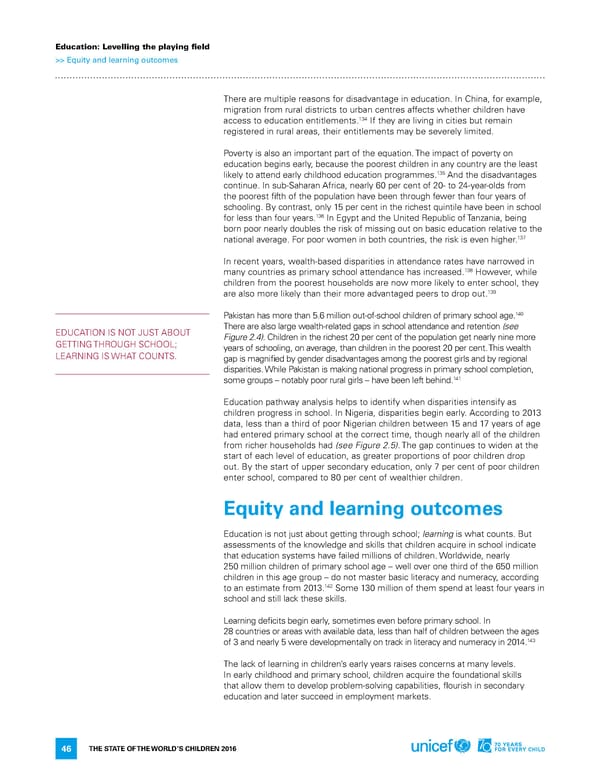Education: Levelling the playing field >> Equity and learning outcomes There are multiple reasons for disadvantage in education. in China, for example, migration from rural districts to urban centres affects whether children have 134 access to education entitlements. if they are living in cities but remain registered in rural areas, their entitlements may be severely limited. Poverty is also an important part of the equation. The impact of poverty on education begins early, because the poorest children in any country are the least likely to attend early childhood education programmes.135 and the disadvantages continue. in sub-Saharan africa, nearly 60 per cent of 20- to 24-year-olds from the poorest fifth of the population have been through fewer than four years of schooling. By contrast, only 15 per cent in the richest quintile have been in school 136 for less than four years. in egypt and the United republic of Tanzania, being born poor nearly doubles the risk of missing out on basic education relative to the 137 national average. for poor women in both countries, the risk is even higher. in recent years, wealth-based disparities in attendance rates have narrowed in many countries as primary school attendance has increased.138 however, while children from the poorest households are now more likely to enter school, they are also more likely than their more advantaged peers to drop out.139 140 Pakistan has more than 5.6 million out-of-school children of primary school age. edUCaTion iS noT JUST aBoUT There are also large wealth-related gaps in school attendance and retention (see GeTTinG ThroUGh SChool; Figure 2.4). Children in the richest 20 per cent of the population get nearly nine more years of schooling, on average, than children in the poorest 20 per cent. This wealth learninG iS WhaT CoUnTS. gap is magnified by gender disadvantages among the poorest girls and by regional disparities. While Pakistan is making national progress in primary school completion, some groups – notably poor rural girls – have been left behind.141 education pathway analysis helps to identify when disparities intensify as children progress in school. in nigeria, disparities begin early. according to 2013 data, less than a third of poor nigerian children between 15 and 17 years of age had entered primary school at the correct time, though nearly all of the children from richer households had (see Figure 2.5). The gap continues to widen at the start of each level of education, as greater proportions of poor children drop out. By the start of upper secondary education, only 7 per cent of poor children enter school, compared to 80 per cent of wealthier children. Equity and learning outcomes education is not just about getting through school; learning is what counts. But assessments of the knowledge and skills that children acquire in school indicate that education systems have failed millions of children. Worldwide, nearly 250 million children of primary school age – well over one third of the 650 million children in this age group – do not master basic literacy and numeracy, according to an estimate from 2013.142 Some 130 million of them spend at least four years in school and still lack these skills. learning deficits begin early, sometimes even before primary school. in 28 countries or areas with available data, less than half of children between the ages 143 of 3 and nearly 5 were developmentally on track in literacy and numeracy in 2014. The lack of learning in children’s early years raises concerns at many levels. in early childhood and primary school, children acquire the foundational skills that allow them to develop problem-solving capabilities, flourish in secondary education and later succeed in employment markets. The STaTe of The World’S Children 2016 46
 70 Years for Every Child Page 61 Page 63
70 Years for Every Child Page 61 Page 63